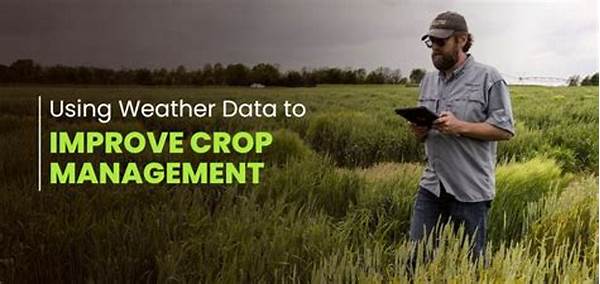In the contemporary agricultural landscape, precision in farming practices is paramount. One of the critical aspects that significantly influences crop productivity is the weather. Understanding and predicting weather patterns can facilitate informed decision-making in crop management. The accuracy and reliability of weather forecasts have exponentially improved with the advent of advanced meteorological tools and technologies. The integration of weather forecast data into crop management practices can enhance yield quality, reduce loss, and optimize resource usage. As climate becomes increasingly unpredictable, leveraging weather forecasts is essential in ensuring sustainable agricultural practices.
Read Now : **frameworks For Assessing Research Integration**
Importance of Weather Forecast in Crop Management
Weather forecasts play an instrumental role in agronomy by providing farmers with crucial information regarding climatic conditions. Timely access to this data assists in strategic planning and execution of various farming activities such as sowing, irrigation, and harvesting. A comprehensive weather forecast for crop management assists in anticipating adverse conditions and taking preemptive measures to mitigate potential damage. These forecasts are particularly vital in regions susceptible to climatic extremes, thereby ensuring food security and economic stability.
Furthermore, the application of weather forecasts in crop management allows for the optimization of inputs such as water, pesticides, and fertilizers. By aligning farming practices with predicted weather patterns, resources are utilized more efficiently, leading to cost savings for farmers. Enhanced predictability through accurate weather forecasts helps in managing risk and improving resilience against climate change. Ultimately, the adoption of weather forecast data into crop management strategies not only elevates productivity but also promotes environmental sustainability.
Strategies for Utilizing Weather Forecasts
1. Sowing Schedule Optimization: Utilizing weather forecast for crop management can aid in determining the most opportune time for planting, thereby enhancing germination rates and seedling development.
2. Irrigation Planning: By anticipating precipitation events through weather forecasts, farmers can optimize water usage, resulting in more efficient irrigation practices.
3. Pest and Disease Control: Weather forecasts can predict conditions favorable for pest outbreaks or disease proliferation, enabling farmers to take timely preventive measures.
4. Harvest Scheduling: Accurate weather forecasts assist in planning the harvest to avoid adverse weather conditions that could compromise crop quality and yield.
5. Risk Management: Weather forecasts provide critical data that can be used to develop contingency plans for extreme weather events, safeguarding the agricultural output.
Technological Advancements in Weather Forecasting
In recent years, significant technological advancements have been made in the field of meteorology, resulting in more precise weather forecasts for crop management. Satellite imagery, remote sensing, and data analytics have revolutionized how weather-related data is collected and interpreted. These technologies provide real-time, localized weather forecasts that are invaluable for farmers making day-to-day decisions. Incorporating such high-tech solutions into agriculture can considerably increase the efficiency and accuracy of farming operations.
Moreover, the proliferation of mobile technology has enabled farmers to receive weather forecasts directly, regardless of their geographical location. Applications specifically designed for agricultural purposes provide tailored forecasts and alerts, which are crucial in making timely decisions. By integrating the latest weather forecast technologies into crop management practices, farmers can effectively address the challenges posed by climatic variabilities and mitigate potential risks, thereby ensuring agricultural sustainability and productivity in the long term.
Applications of Weather Forecasting Tools
The implementation of sophisticated weather forecasting tools in crop management has become increasingly widespread. These tools offer 10 key benefits:
1. Enhanced Decision-Making: Weather forecasts enable data-driven decisions.
2. Resource Optimization: Efficient use of water and fertilizers.
3. Yield Improvement: Better planning leads to higher yields.
4. Risk Reduction: Mitigate impacts of adverse weather.
Read Now : High-quality Research Metrics
5. Cost Efficiency: Reduce unnecessary agricultural expenses.
6. Sustainability: Promote environmentally friendly practices.
7. Increased Resilience: Adaptability to climate change.
8. Time Management: Optimize farm operation schedules.
9. Advanced Warnings: Prepare for extreme weather.
10. Tailored Solutions: Custom forecasts for specific needs.
Challenges in Weather Forecast Application
Despite significant advantages, there are challenges associated with applying weather forecasts in crop management. First, the accuracy of forecasts is not always guaranteed, particularly in regions with unstable climates. Additionally, the accessibility of technology and information among smallholder farmers is often limited, hindering widespread adoption. There is also the issue of data interpretation, as farmers may lack the expertise to apply complex meteorological data to practical agricultural activities.
Efforts to overcome these obstacles include improving the accessibility of forecasting technologies through government initiatives and private sector involvement. Ensuring that farmers are well-educated on interpreting forecast data and implementing the necessary agronomic adjustments is crucial. Moreover, ongoing research and development in meteorology aim to continually enhance the precision and reliability of weather forecasts.
By addressing these challenges, the integration of weather forecast data into crop management can be universally adopted, maximizing productivity and sustainability. Tailored training programs and community initiatives can empower all farmers to reap the benefits of precise weather forecasts, thereby supporting global food security goals.
Conclusion and Future Prospects
In conclusion, the integration of weather forecast for crop management represents a fundamental shift towards precision agriculture. The benefits are profound, from optimizing resources to improving yield predictability. However, maximizing these benefits requires overcoming technological and educational barriers. As advancements in weather forecasting continue, their application in agriculture will become more integral to sustainable farming practices.
Future prospects suggest a more intertwined relationship between meteorology and agriculture, as precision technologies become more accessible and reliable. Continuous collaboration between meteorologists, agronomists, and farmers will ensure that weather forecast for crop management evolves to meet the growing needs of the agricultural sector. Ensuring the proliferation of these technologies depends on collaborative efforts to provide farmers with the knowledge and tools they need, paving the way for a resilient and food-secure future.
